The Bluetti AC300 vs. BougeRV Rover 2000 comparison comes down to how much power you need and how far you’re willing to carry it. The Bluetti AC300 is all about muscle, with high-amp outputs and modular expansion for serious setups. Meanwhile, the BougeRV Rover 2000 is more compact and portable, designed for users on the go with a unique, lightweight battery.
Whether you’re powering a campsite or preparing for outages, we’ll explore which power station suits your lifestyle best. Is the Bluetti AC300 better than the BougeRV Rover 2000?
We carefully select the products and services we link to. If you buy through our links, we may earn a commission. There’s no extra cost to you and it helps us provide this information.

Quick Analysis: Raw Power vs. Advanced Portability
This comparison offers something unique for two very different needs, depending on how much power you want and how often you’ll be on the move. If you’re looking for high-powered home backup or RV support, the Bluetti is your pick. But for those seeking a more portable option with cutting-edge battery tech, the BougeRV Rover makes a strong case.
In this power station comparison, the Bluetti AC300 stands out because:
- Larger battery and inverter capacity
- High-amp outputs for RV and major home backup use
- Serious modular expansion
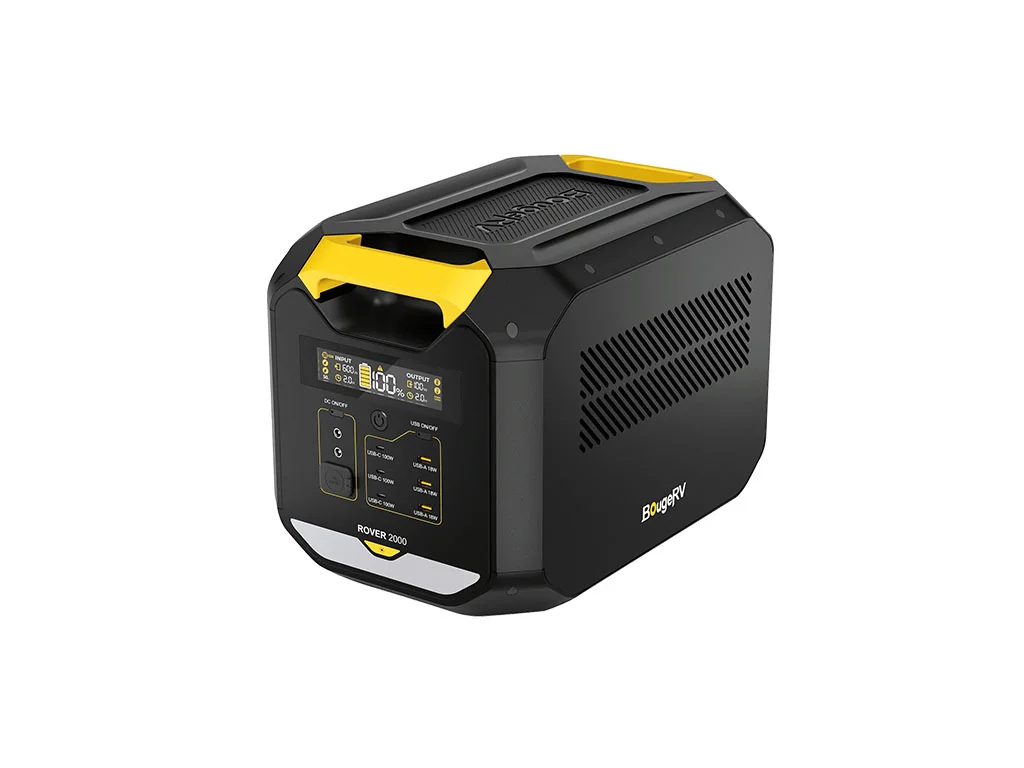
Bluetti is likely a more familiar name in power stations, but BougeRV is quickly proving it can compete with the best. Built by adventure-seekers, BougeRV focuses on outdoor electronics and is gaining traction in power stations and portable fridges. Though smaller, the brand’s impressive warranty and performance make it one to watch, much like Bluetti was when it first started.
There’s no sugarcoating it. We prefer the power and features of the Bluetti AC300. But we’re not completely shunning the BougeRV Rover 2000. It has unbeatable portability and innovation:
- Insanely lightweight and compact design
- Innovative semi-solid state battery
- Capable power output
As far as price goes, the Bluetti AC300 is more expensive. With its significantly more robust capabilities, that makes sense. If you equalize the price by looking at it on a per battery watt-hour basis, these are actually offered with similar values, aligned with some of the best in the industry at about $0.90 per Wh or less. And that makes both quite attractive.
You pay about the same per Wh. One is more expensive (Bluetti) because of more watt-hours. The other (BougeRV) offers an innovative technology and extremely lightweight system you can’t find elsewhere at a competitive price.
While the Bluetti AC300 tugs on our heart strings with its overall power, modular expansion, and high-amp outputs, there’s a spot for this future-forward BougeRV Rover 2000 in some gear kits. It’s a great system that can deliver big on power even if your storage space is limited. We recommend the Bluetti for home backup and spacious RV use. But the BougeRV Rover 2000 is a better fit in compact camping rigs or homes with limited space (or lightweight needs) as long as you do not need high-amp output.
In the end, it’s about striking the right balance for your situation between power and portability.

|
BLUETTI AC300 |
AC300 on Bluetti AC300 on Amazon |

|
BougeRV ROVER2000 |
Buy on BougeRV Buy on Amazon |
Detailed Comparison: Bluetti AC300 vs. BougeRV Rover 2000
We’ve shown you the quick look. Now we’re going in and getting our hands dirty with the details. As we do so, we’ll make sure to translate the complicated specs into real-world takeaways you can understand. No unsubstantiated marketing claims here.
We’ll break this down into the following categories:
- What Can These Power? Inverter and Outputs
- How Long Does it Last? Battery Details
- How Fast Do They Charge? Charging Inputs
- Can You Carry it Easily? Portability
- Which Should You Buy? Final Verdict
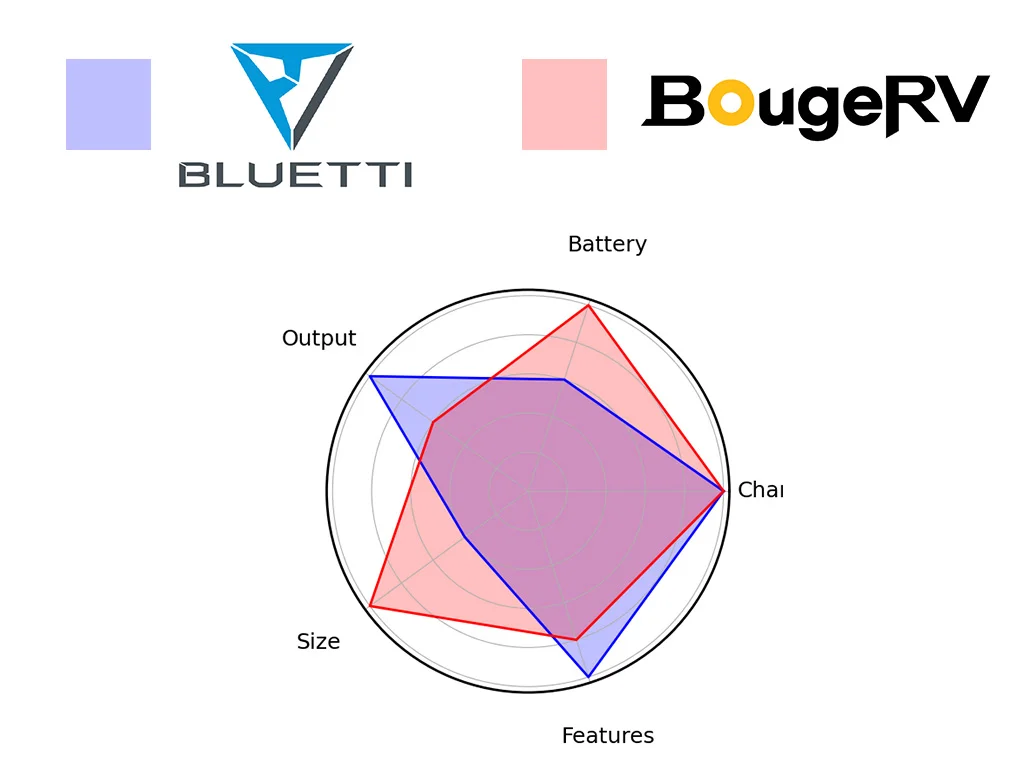
Powering Your Devices: Inverters and Outputs
The inverter is the key to converting DC power from the battery into AC power, which runs most of your household appliances. The Bluetti AC300 packs a 3,000W inverter with a 6,000W peak, while the BougeRV Rover 2000 offers a 2,200W inverter with 4,000W peak.
Here’s a quick breakdown of what either one of these inverters can power:
- Low-watt devices: Laptops (~60W), WiFi routers (~30W)
- Medium-watt devices: Mini-fridges (~100W), TVs (~150W)
- High-watt devices: Full-size fridges (~500W), microwaves (~1,000W)
Running multiple devices together? A full-size fridge (~500W) plus a TV (~150W) leaves plenty of room for smaller gadgets. Running two high-watt devices (like a fridge and microwave) could push the limits of the BougeRV. For heavy-duty setups, 3,000W covers most needs, while 2,200W may struggle with multiple high-watt devices.

The Bluetti can also double up with two AC300 units. This not only creates a whopping 6,000W output, it also provides 240V supply, useful for home backup needs and serious appliances.
There are many outputs on both power stations. All the AC outlets you could need, plus a handful of USB ports and other DC outlets for inverter-free energy.
However, the Bluetti has two high-amp outlets, one AC and one DC. It is a far better choice if you’re looking to connect to a home transfer switch or power a DC fuse box.

You’ll find an uninterruptible power supply (UPS) feature with a 20ms transfer time on the Bluetti AC300 and the BougeRV 2000. Your critical devices will stay powered during outages.
Output Verdict: The Bluetti AC300 takes the lead with high-amp outlets and greater overall power. It’s the right choice for a home backup transfer switch and RV shore power setups. The BougeRV Rover 2000 excels in smaller setups or for users seeking portability over raw power. The 2.2kW inverter can handle large appliances, but you’ll have to plug them in directly to the power station.
| Product | BLUETTI AC300 | BougeRV Rover 2000 |
|---|---|---|
| AC Output | 3,000W | 2,200W |
| AC Output (System Max) | 6,000W | 2,200W |
| AC Output Peak | 6,000W | 4,000W |
| 120V Outlets | 7 total (6x20A; 1x30A) | 5 |
| 240V Outlets | – | – |
| UPS / EPS | 20ms | 20ms |
| USB-A Ports | 2x15W; 2x18W | 3x18W |
| USB-C Ports | 1x100W | 3x100W |
| Other DC (Anderson or other) | 30A | – |
| DC 5521 (Barrel Plug) | – | 2x136W |
| Cigarette Lighter | 1x240W | 1x136W |
| Wireless Charging Pad | 2x15W | – |
| Connectivity | WiFi / Bluetooth | – |
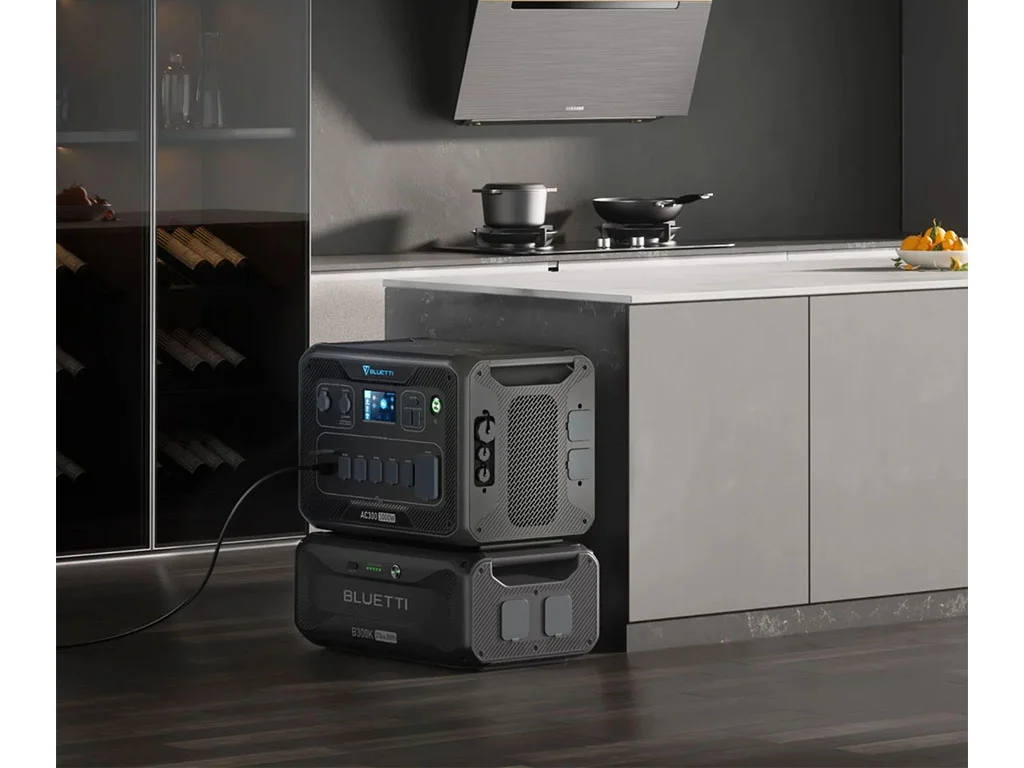
Lasting Long: Battery Capacity and Lifespan
Battery capacity, measured in watt-hours (Wh), determines how long a power station can run your devices. The Bluetti AC300 offers 2,765Wh, while the BougeRV Rover 2000 has 2,008Wh. However, real-world inefficiencies (like heat loss, inverter use, and unusable capacity) can reduce the actual output by about 20%.
Before we see exactly what that means, the BougeRV batter is worth some immediate attention. Most power stations now use LiFePO4 (LFP) batteries. Not the Rover 2000. BougeRV has introduced one of the only semi-solid lithium batteries in a portable power station. And that means you get nearly identical longevity and performance as the LiFePO4 but will significantly less weight and size.
This innovative BougeRV battery is a highlight that translates to extreme portability unmatched in the entire industry.
Now let’s see what these batteries can do. The Bluetti AC300 could power a 60W laptop for roughly 37 hours, while the BougeRV Rover 2000 can handle about 27 hours. Heavier draws like a home fridge, TV, and router (~500W) will run 4.4 hours on the Bluetti and about 3.2 hours on the BougeRV.
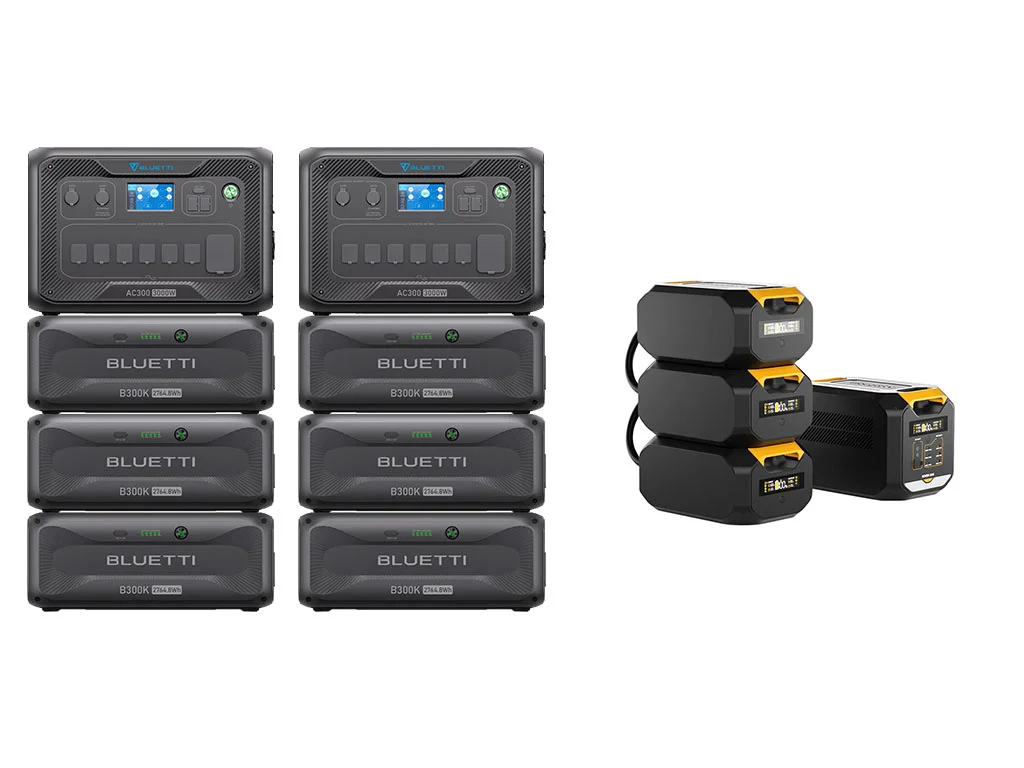
The magic of these units is the modular battery expansion. You can stack on extra batteries to extend this runtime significantly.
The Bluetti AC300 can go up to 11kWh per AC300 (which means 22kWh with two AC300 units is possible). BougeRV has an impressive 8kWh total battery potential, not quite matching up to the AC300 though.
Battery Verdict: We see a major benefit in the BougeRV Rover 2000’s semi-solid battery type, pushing bleeding-edge technology forward before other brands and getting a lighter, smaller power station in return. Yet the Bluetti AC300 has superior battery capacity, both as a single unit and a maximum system.
| Product | BLUETTI AC300 | BougeRV Rover 2000 |
|---|---|---|
| Battery | 2,765Wh | 2,008Wh |
| Battery (System Max) | 22,118Wh | 8,032Wh |
| Warranty | 4 years | 5 years |
| Battery Type | LiFePO4 / LFP | Semi-Solid |
| Battery Cycles | >3,000 | >3,000 |
| Buy Now | Buy AC300 | Buy Now |
| Buy on Amazon | AC300 on Amazon | Buy on Amazon |

Charging Speeds and Input Options
Quick charging speeds are crucial when you need to top off your power station between uses. Whether you’re using AC power, solar panels, car charging, or a fuel generator, faster charging means less downtime.
The Bluetti AC300 supports up to 3,000W of AC input, allowing it to fully recharge in about 1.1 hours, and can take in up to 2,400W of solar input for fast sun-powered recharges in around 1.4 hours. It even supports simultaneous AC and solar inputs for faster turnaround.
In comparison, the BougeRV Rover 2000 charges via AC at 1,500W, taking about 1.6 hours. It supports up to 1,500W of solar input, with a similar charge time under ideal conditions. These are still lightning-fast charging times and are well-suited for the slightly smaller battery size.
You can also get better car charging with devices like the Pecron 500W DC Car Charger or the Bluetti Alternator Charger 1.
Charging Verdict: The Bluetti AC300 has faster charging speeds, but the BougeRV Rover 2000 still provides solid speeds for its size. This is a tie as both are well-matched to the system.
| Product | BLUETTI AC300 | BougeRV Rover 2000 |
|---|---|---|
| AC Input | 3,000W | 1,500W |
| AC Recharge Hours (Est.) | 1.1h | 1.6h |
| Solar Input | 2,400W | 1,500W |
| Solar Recharge Hours (Est.) | 1.4h | 1.6h |
| Solar Input (System Max) | 4,800W | 1,500W |
| Solar Input 1 Watts | 1200W | 1500W |
| Solar Input 1 Volts Min | 12V | 11V |
| Solar Input 1 Volts Max | 150V | 100V |
| Solar Input 1 Amps | 12A | 30A |
| Solar Input 2 Watts | 1200W | – |
| Solar Input 2 Volts Min | 12V | – |
| Solar Input 2 Volts Max | 150V | – |
| Solar Input 2 Amps | 12A | – |

Size, Weight, and Portability Specs
Weight and dimensions play a huge role in usability. Unlike DIY systems that are locked in place, a portable power station can go wherever you do. As long as it’s small and light enough.
These look nearly identical but that’s actually far from true. The Bluetti AC300 requires an external battery. It does not have an internal battery. So even though they’re both about 47 lbs (21 kg), the Bluetti still needs another monster battery tacked on to that figure.
The Bluetti AC300 is also much larger, even WITHOUT the battery. It’s about the size of a piece of carry-on luggage while the BougeRV Rover 2000 is about the size of a microwave.
Portability Verdict: The BougeRV Rover 2000 is far more portable that almost any power station in this segment. The semi-solid battery tech shows its prowess. The Bluetti AC300 does better than some by keeping weight down by excluding the battery, but it’s no match for the extremely compact Rover 2000.
| Product | BLUETTI AC300 | BougeRV Rover 2000 |
|---|---|---|
| Weight (lbs) | 47.6lbs | 47lbs |
| Weight (kg) | 21.6kg | 21.3kg |
| Dimensions (in) | 20.5×12.5×14.1in | 15.7×10.6x11in |
| Dimensions (mm) | 520x320x358mm | 400x270x285mm |
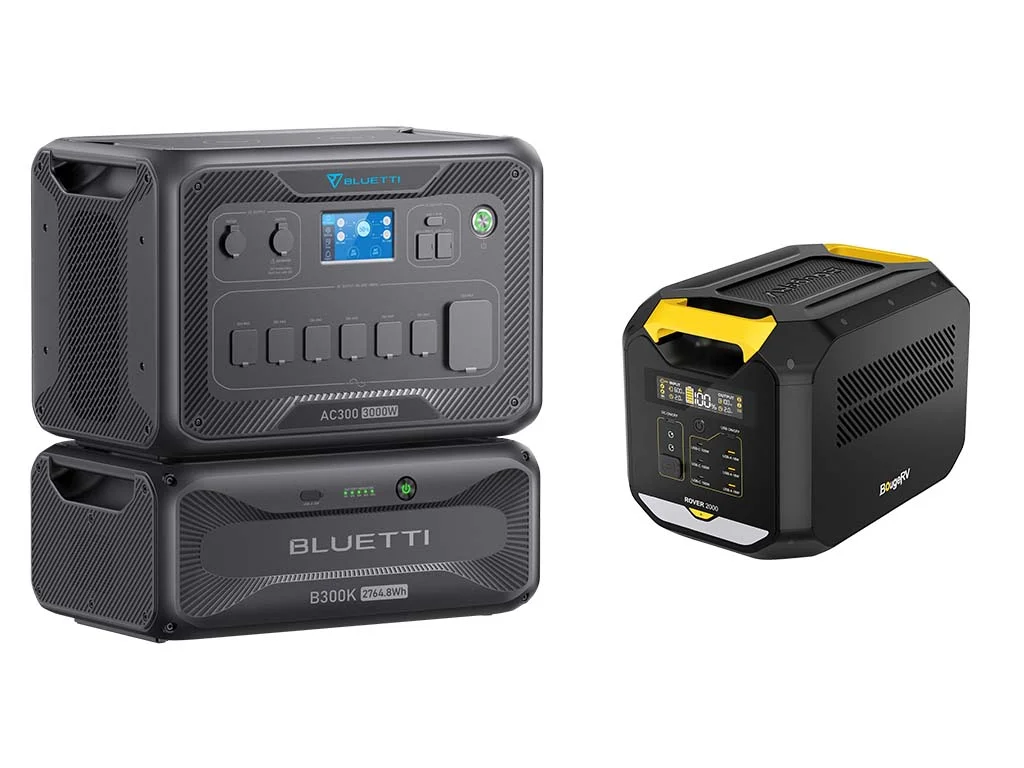
Final Verdict: Our Power Pick
These two power stations offer solid features, but cater to different needs. It’s surprising to see power stations with such different specs have such a close faceoff. BougeRV truly pulls a miracle out of its sleeve with the semi-solid battery, allowing for extremely compact size.
Yet the Bluetti AC300 has the clear advantage for power, including a better inverter, high-amp outputs, and more battery expansion. It’s the better choice for those needing serious energy for home backup or extended off-grid setups. However, its heavier weight and larger size make it less portable than its competitor.
The BougeRV Rover 2000 is a portability-focused masterpiece, perfect for camping or road trips without sacrificing too much in performance.
| Bluetti AC300 | BougeRV Rover 2000 |
|---|---|
Key Takeaways:
- Inverter and Outputs: Bluetti handles heavier loads, while BougeRV is better for simpler setups.
- Battery Capacity: Bluetti wins with more power and expandability, but BougeRV is only shortly behind when you compare single-unit specs and extra batteries. And it uses an advanced battery type that’s pushing the industry forward.
- Charging Speeds: Bluetti charges faster with higher input options yet BougeRV’s rates are perfectly suitable for the size.
- Portability: BougeRV leverages its advanced battery tech to absolutely destroy the competition as far as weight and size go.
- Price: The value of both is superb, with price per Wh about equal (and low).
Final Recommendation: It comes down to your needs. If you need high-amp outputs for home backup use or powering an RV’s shore power inlet, the Bluetti AC300 is the right call. But if you’re on the move or looking for a big power station that’s easiest to carry around and use anywhere, the BougeRV Rover 2000 is an excellent choice.

|
BLUETTI AC300 |
AC300 on Bluetti AC300 on Amazon |

|
BougeRV ROVER2000 |
Buy on BougeRV Buy on Amazon |
Specs Comparison Chart: Bluetti AC300 vs. BougeRV Rover 2000
Below is a detailed comparison chart for the Bluetti AC300 and the BougeRV Rover 2000. We also include links to the user manuals so you can check out more details if needed.
| Product | BLUETTI AC300 | BougeRV Rover 2000 |
|---|---|---|
| Battery | 2,765Wh | 2,008Wh |
| Battery (System Max) | 22,118Wh | 8,032Wh |
| AC Output | 3,000W | 2,200W |
| AC Output (System Max) | 6,000W | 2,200W |
| AC Output Peak | 6,000W | 4,000W |
| AC Input | 3,000W | 1,500W |
| AC Recharge Hours (Est.) | 1.1h | 1.6h |
| Solar Input | 2,400W | 1,500W |
| Solar Recharge Hours (Est.) | 1.4h | 1.6h |
| Solar Input (System Max) | 4,800W | 1,500W |
| Warranty | 4 years | 5 years |
| Weight (lbs) | 47.6lbs | 47lbs |
| Weight (kg) | 21.6kg | 21.3kg |
| Dimensions (in) | 20.5×12.5×14.1in | 15.7×10.6x11in |
| Dimensions (mm) | 520x320x358mm | 400x270x285mm |
| Solar Input 1 Watts | 1200W | 1500W |
| Solar Input 1 Volts Min | 12V | 11V |
| Solar Input 1 Volts Max | 150V | 100V |
| Solar Input 1 Amps | 12A | 30A |
| Solar Input 2 Watts | 1200W | – |
| Solar Input 2 Volts Min | 12V | – |
| Solar Input 2 Volts Max | 150V | – |
| Solar Input 2 Amps | 12A | – |
| Battery Type | LiFePO4 / LFP | Semi-Solid |
| Battery Cycles | >3,000 | >3,000 |
| 120V Outlets | 7 total (6x20A; 1x30A) | 5 |
| 240V Outlets | – | – |
| UPS / EPS | 20ms | 20ms |
| USB-A Ports | 2x15W; 2x18W | 3x18W |
| USB-C Ports | 1x100W | 3x100W |
| Other DC (Anderson or other) | 30A | – |
| DC 5521 (Barrel Plug) | – | 2x136W |
| Cigarette Lighter | 1x240W | 1x136W |
| Wireless Charging Pad | 2x15W | – |
| Connectivity | WiFi / Bluetooth | – |
| User Manual | User Manual | User Manual |
| Buy Now | Buy AC300 | Buy Now |
| Buy on Amazon | AC300 on Amazon | Buy on Amazon |

|
BLUETTI AC300 |
AC300 on Bluetti AC300 on Amazon |

|
BougeRV ROVER2000 |
Buy on BougeRV Buy on Amazon |
The End Result
The Bluetti AC300 stands out for its higher power capacity, high-amp outputs, and superior modular expandability. If you want to power a home transfer switch or shore power inlet, it’s the right choice even though it’s bulkier and less portable.
With an advanced semi-solid battery, the BougeRV Rover 2000 takes portability to a new level while still offering a whole lot of battery power, modular expansion, and capabilities. Just don’t look for a high-amp output or else you’ll be disappointed.
Ready for more in-depth analysis? Explore our full Bluetti AC300 review and BougeRV Comparison Charts. You can also check out our other comparison articles:
- Bluetti AC300 vs. EcoFlow Delta Pro 3
- Bluetti AC300 vs. Jackery 2000 Plus
- BougeRV Rover 2000 vs. Jackery 2000 v2
- Bluetti Comparison Charts
Now is the time to make your decision. Order your power station today and discover the confidence behind never worrying about power outages or roaming free of campground outlets.







